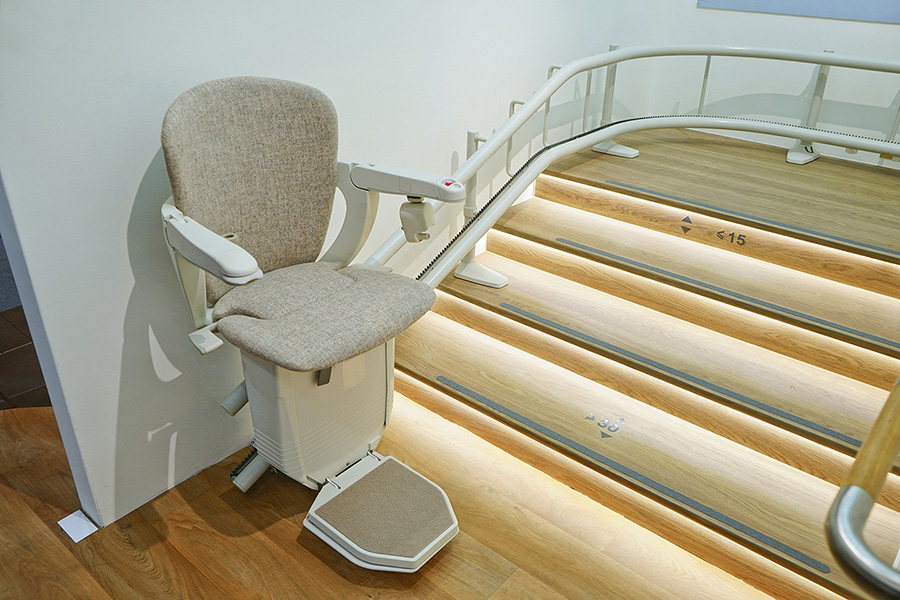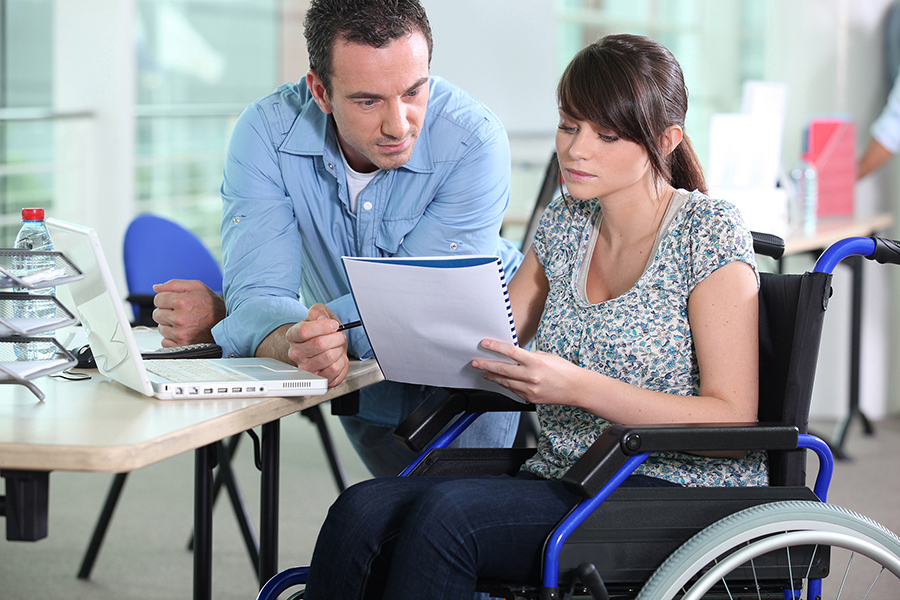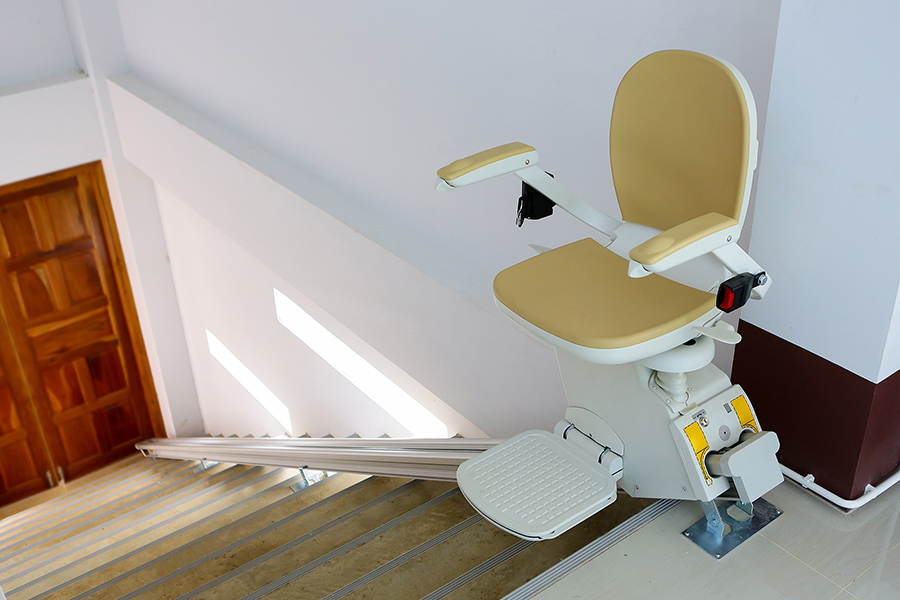Last Updated on 01/11/2023 by Sarah Sarsby
There are currently over 23 million households in the UK, many in buildings more than 50 years old and most of which contain steps. This isn’t a problem when you have no difficulty climbing stairs, but if – for whatever reason – even a couple of steps becomes a major barrier or physical hazard, your own home can suddenly quite seriously disable you.
When this happens, you are left with four choices: do nothing, all too quickly losing the ability to live independently in your own home; you can re-organise the house in order to live and sleep downstairs; you can move to a bungalow or ground floor flat; or you can install some form of domestic lift, such as a stairlift or a through-the-floor lift. This last option is likely to be the least distressing, the most practical, and financially prudent means of ensuring you retain as much independence as possible.

When installing a domestic lift, your first move should be to get an independent assessment of your daily living needs by a BHTA stairlift member. Occupational therapists (OTs) and other healthcare professionals can often offer independent advice, not only on potential access solutions, but also on the variety of grants and funding options that may be available to help with the cost, which will be financially means tested.
Independent Living Centres can also help. This discussion will help you to decide how best to solve your problems, and you’ll be in a much better position to get the support and facilities you need.
Domestic lifts, such as a stairlift or a through-the-floor lift, come in a variety of forms; your final choice ultimately depends on your own particular needs and situation. There is a misconception that many people think that stairlifts are fixed to the wall. All stairlifts are fixed to the stairs, not the wall.
Fixed stairlifts are powered mechanisms mounted on stair-fixed tracks, which follow the line of the stairwell (so can be either “straight” or “curved”). A majority of these are used by people who can walk but find stairs a problem; the user is normally seated during transfer, although some models allow you to perch or stand, which might be preferable if you have difficulty bending your knees.
There are also fixed stairlifts with a wheelchair platform, but although the platform usually folds up against the wall, they do take up a lot of room and many domestic stairwells may not be broad enough.
A through-floor or homelift may be ideal if you are able to stand or sit and come in compact or wheelchair accessible sizes.
Naturally, building work is involved to create the aperture for a lift, but your homelift provider will be able to take care of that for you. Homelifts are more expensive than some stairlifts.
Short rise lifts are ideal for coping with small changes in floor level – at a front step or in a split-level hallway – where there is insufficient space to put a ramp. Some structural work may be required to ensure that the main mechanism is sunk below ground level.
The value of a professional assessment by a local BHTA stairlift member cannot be over-emphasised, as there are lots of questions that need to be answered before you can proceed. For example:
Your physical condition could deteriorate, so it may be wiser to consider installing a through-the-floor lift so that, in the future, it can accommodate a wheelchair.
You need to take into consideration the home environment, not just in relation to the physical things like doors, bulkheads, and radiators, but also family members, pets, and visitors.
Make sure a stairlift covers the whole length of the staircase if you’re buying second-hand; one that covers 11 stairs in one house might only cover 10 in yours.
All installations should be carried out by a manufacturer-trained engineer. It is advisable not to use untrained staff for installation.
Check whether the company you’re dealing with is a member of the BHTA. All BHTA members commit to a Code of Practice, approved by the Chartered Trading Standards Institute. The code sets out the levels of service you can expect from the company.

Choosing the right stairlift will make a great deal of difference to your comfort and confidence in using it. There are various aspects to consider and products designed to suit different needs.
Stairlifts can be fitted to most properties. If you have a curved, spiral, or unusually shaped staircase it may be possible to install a more specialist product. Outdoor steps and stairs can also be accommodated. These come with water-resistant components and covers protecting them from the elements.
All manufacturers make lifts for straight stairs, so there are many models to choose from.
You might feel able to get off the lift and walk up the last few steps, but you need to decide if you are likely to be able to go on doing this. If you need to travel the entire way to the top of the staircase, you may need to consider a curved stairlift from the outset. Always seek advice from your stairlift installer if you are unsure of the right model for your application.
Curved stairlifts are made bespoke to the staircase and, in some cases, can even be fitted to spiral stairs.
You always have to think about how much room you need for your knees or feet to accommodate you on a stairlift in a seated position. It is worth talking to a specialist BHTA member, as there are variations between models and they can guide you through the assessment.
If there is a door close to the bottom of the stairs, the stairlift may have to travel across it. To avoid everyone using the door and stepping over the rail, most lifts have folding rails as an optional extra, which lift the rail up and out of the way. Changing the stairlift to the opposite side of the staircase may be another solution.
In most houses, there is enough space at the top and bottom of the stairs for getting on and off the lift comfortably. In some houses, you have to be careful not to bang your knees on radiators or other obstructions. Consider removing any obstructions (radiators may be re-sited or replaced with smaller models for convenience). Seek advice from your stairlift installer.
You can park the lift at the top or the bottom because you can send it back up or down the stairs once you have got off. Some curved lifts can also have intermediate park points.
If you use a wheelchair, you need to be able to transfer on and off a stairlift seat and to sit in it safely. If you cannot transfer, you will need to think about a stairlift with a wheelchair platform or a vertical lift.
Stairlifts need to be comfortable to sit on. All the models come with a safety belt that you should always use. If you have stiff limbs or difficulty bending your knees, it may be easier to choose a lift with a footrest you stand on and a perching stairlift, which has a small, high seat or ledge to give support during travel. You may consider a downward facing seat.
If other people use the stairs and you have a narrow hall and landing, you will probably need to fold the lift up when you are not using it. The armrests and footrests fold on all models with seats. The seats fold too on most models, although, on some, only the front section of the seat flips up.
How easy it will be to get on and off a stairlift is affected by the height of the seat and the amount of space in your hall and landing, so seek advice from your BHTA stairlift member company, which will recommend the best solution for you and your stairs.
As a guide, your minimum seat height should be the distance from the crease at the back of your knee to the floor. Some models have adjustable seat heights, and some will have a one size fits all.
All stairlifts with a seat have two armrests. All armrests lift up to fold back. These can be raised separately to assist you when transferring or standing up. This is particularly helpful if you are transferring across from a wheelchair.
Your BHTA specialist will give you helpful advice and user tips when carrying out an assessment.

Swivel seats help, because you can swing round to face away from the stairs and towards the landing. The swivel is operated by levers which are usually on the side and just below the seat cushion. The size and shape of these varies. Some manufacturers offer a powered swivel option.
Stairlifts usually have two controls – one to switch the power on and off, and one to make the lift move up or down. Most up/down controls are either operated by a joystick or pushbutton, dependent on the model.
On stairlifts the controls are usually on the armrest – either on the top or on the end; but make sure that it is not where you might accidentally switch it on when you are getting on or off the stairlift. This can be a problem if your hand slips easily or if you make involuntary movements.
On standing and perching lifts, the controls are on the guard rail or on the armrest – you can reach them when the seat is folded up. You do have to press the up/down control continuously while the lift is moving – if you don’t it will stop.
Most lifts are supplied with wall-mounted call and send switches at the top and bottom of the stairs. Some manufacturers and suppliers provide handheld and remote call and send switches with their lifts.
All stairlifts are supplied with a seat belt. Some are retractable belts, and some are lap straps. Most manufacturers also offer a harness option.
Diagnostic lamps or displays can guide you should the lift not operate correctly. This is especially helpful when contacting the service engineer. Many simple issues can be resolved over the phone saving on callouts.
The lift can be installed quickly if you are buying directly, using your own money. But it can take several months if you are waiting for a grant.
Installation itself is usually done in a day. You might not be able to use the stairs while the work is being done. Installation will need a power socket so that the stairlift can remain plugged in or wired directly to the spur socket and must remain switched on at all times.
Homelifts and vertical through-floor models will need building work, and this needs to be considered as part of the planning before installation.
If you buy a stairlift direct, the manufacturer or distributor will deliver and install it. This will include all electrical work and the removal of any obstructions on the stairway, such as a handrail. Ask the installer what alterations will be needed, and who will be responsible for them, including any making good.
The running rail for most stairlifts is fitted directly on to the stair treads, so holes have to be made through the carpets. Decorations are affected where the controls are fitted to the walls.
The installer will show you how to operate the stairlift and make sure that you can manage it and that you are comfortable on it. He/she should make any necessary adjustments. Make sure that your feet fit on to the footrest and that it is a comfortable distance from the seat.
You should be given written instructions and a telephone number to use if you have any queries or problems. It’s a good idea to stick the number on the lift.
Any stairlift should meet European Standard BS EN 81-40 as well as the relevant European CE marking. Through-the-floor lifts should meet British Standard BS5900, which covers the installation and the use of powered homelifts.
European Standard BS EN 81-40 requires a number of safety features:
A stairlift is one of the more significant pieces of equipment you are likely to buy to make your house easier to live in. If you do not have the funds yourself, there are different ways to access grants or other financial help.

Grants are available through local authorities for house adaptations and equipment. The main sources are: Disabled Facilities Grant (DFGs) in England, Wales, and Northern Ireland or an Equipment and Adaptations Grant in Scotland. You must apply before buying the stairlift and starting any work.
DFGs are available to disabled people who own or rent their home. They can also be paid to landlords on behalf of tenants. The grant is means-tested, so the amount paid depends on your income and savings. The authority pays the grant but has to consult the social services department to find out if you need the adaptation or equipment and whether it will be appropriate for you. The whole process can take some months and can be subject to a priority waiting list.
DFGs may be mandatory or discretionary. If the work is essential for you to be able to move around your home, you will be considered for a mandatory grant. You may qualify for a grant if your disability makes climbing the stairs virtually impossible and if you need the stairs to reach an essential facility such as a bathroom.
At the time of publishing this article, the latest information about grants and repair assistance is available at the following web addresses:
If you live in housing association property, you may be eligible for the grants described above. Alternatively, a grant can be paid to the housing association if you are assessed as needing an adaptation or equipment.
In England and Wales, grants are available through the Housing Corporation; in Scotland through Scottish Homes; and in Northern Ireland grants come direct from the Department of Environment, Northern Ireland.
If you do not qualify for a grant, or it does not cover the full cost of your stairlift, and you cannot afford the sum required, you might consider approaching social services for some assistance.
National and local fund-giving bodies and charities may be able to give you financial help. Local libraries have directories of these. The Disabled Living Foundation publishes a free fact sheet on sources of finance for disabled people.
You may not have to pay Valued Added Tax (VAT) if you are buying a lift for your own use or you may only have to pay a reduced VAT rate of five percent. You do not have to be registered disabled. The supplier will give you a form to complete if you are eligible.
All new lifts come with a minimum guarantee of 12 months. This covers the cost of parts, labour, and callouts. Most firms supplying second hand lifts give a six- or twelve-month guarantee. Beyond that, the main types of aftersales support are:
As recommended by British safety standards, it is imperative that your lift is serviced annually. This safety check is very important, as it can identify if the lift safety features are all working correctly, and bolts and fittings are tightened and checked.
This is generally an extension of the guarantee. The cost varies between companies and according to how many years you opt for. This cover includes parts, labour callouts, and servicing checks.
This is a cheaper alternative to an extended warranty. It may be the only option available for lifts bought second hand. You book a service, once a year. The cost covers labour, but you have to pay for any replacement parts.
If the lift breaks down and you don’t have a maintenance contract, you will need to call out the manufacturer, retailer, or a repair firm. Typical costs will be comparable to a plumber or electrician’s callout charge, excluding parts. Before taking on any type of maintenance contract, check what it includes and hours of callout availability.

Depending on where you live and how you buy your stairlift, you may be able to get help with servicing costs from your council, registered social landlord, or social services. This is dependent on local policies, but it is worth making enquiries before you enter into any service agreement. Check if you are required to pay for any maintenance work if the lift is supplied as part of a grant.
The warranties offered by stairlift firms cover the lift only for mechanical failure. If you want cover against accidental damage, and things like fire, theft, or flooding, you will need to take out insurance on the lift.
Insurance companies vary in whether they insure stairlifts under contents or buildings policies, or indeed at all. Always tell your insurance company when you are having a stairlift installed.
If your local authority is responsible for the stairlift and for servicing, it might also pay for insuring it.
Specialist insurers are able to give specific policies for stairlifts. Information on these can be acquired from your stairlift supplier.
A national charity providing independent advice on mobility aids, disability aids, daily living equipment. Certified as a producer of reliable health and social care information.
Telephone: 0300 999 0004
Offering clear, practical advice, this is a website that lets you read reviews of products and add your own comments.
Tel: 020 3141 4600
An independent research charity providing free practical and detailed guidance for older and disabled consumers. RiDC has an online guide to choosing and buying a stairlift.
Telephone: 020 7427 2460